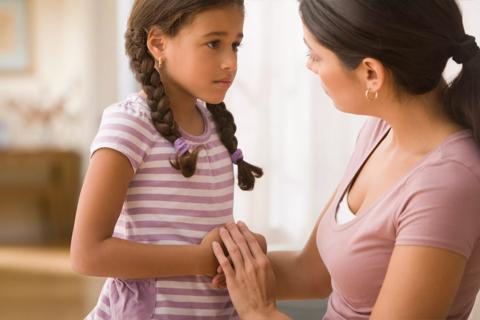How to know when a stomachache is something more serious

When your child is feverish and nauseous with a stomachache, it’s usually just a 24-hour bug. Symptoms are often curbed with chicken noodle soup, lots of liquids, cuddles and the promise of watching their favorite TV show all day long.
Advertisement
Cleveland Clinic is a non-profit academic medical center. Advertising on our site helps support our mission. We do not endorse non-Cleveland Clinic products or services. Policy
As a parent, those 24 hours can be stressful, waiting for their fever to break and their stomach pain to ease. But what should you do on the off chance symptoms linger and don’t seem to improve? If this is the case, your child could be suffering from pancreatitis – an inflammation of the pancreas – which has symptoms that are quite similar to a stomach virus. Although we typically only hear about pancreatitis being a problem for adults, children also can be affected.
In adults, gallstones and alcohol are the two leading causes of pancreatitis and can cause major illnesses, with prolonged hospitalization. Luckily in children, the causes often are different and illness is less frequent.
“To reduce the risk of complications, it’s important for parents to recognize the symptoms of pancreatitis early and make an appointment with your pediatrician,” says pediatric gastroenterologist and hepatologist Kadakkal Radhakrishnan, MD.
There are two main types of pancreatitis: acute and chronic. When pancreatitis occurs one time, it’s known as acute pancreatitis, and when it occurs repeatedly, it’s called chronic pancreatitis. Long-term health issues can develop when pancreatitis doesn’t heal or improve. For example, your pancreas can become scarred and develop calcium deposits in the digestive gland, as well as sludge and stone in the pancreatic duct.
Advertisement
Your pancreas is a digestive gland in the back of the abdominal cavity. It makes digestive juices that drain into the upper part of your small intestine, and it’s important in the digestion of carbohydrates, fats and proteins.
It’s an amazing phenomenon that the pancreas, despite making the digestive juices, never digests itself due to the natural checks and balances in the gland. When these checks and balances are interrupted, that’s when pancreatitis can occur.
“In children, the exact cause of pancreatitis is unknown half the time,” Dr. Radhakrishnan says. Acute pancreatitis may be caused by medications, a viral infection or trauma. On the other hand, recurrent pancreatitis may be due to genetic defects or due to congenital abnormalities in the pancreatic duct.
There are a few genetic disorders associated with a higher risk of developing pancreatitis. Although these are rare, two relatively common genetic defects associated with repeated pancreatitis include cystic fibrosis (CF). Gene changes and mutations cause the activation of a digestive enzyme called trypsin in the pancreas in those with CF.
Pancreatitis can be extremely painful for children. “If your child complains of persistent upper abdominal pain — often to the middle and left and sometimes with radiation of pain to the back — that could be a sign that it’s more than just the flu or a tummy ache,” says Dr. Radhakrishnan.
Other common symptoms of pancreatitis in children are:
Pancreatitis can be difficult to diagnose, and it takes a high degree of suspicion to start testing for it. The best screening test for acute pancreatitis is a simple blood test that looks for the elevation of two enzymes: amylase and lipase.
An ultrasound also may be a helpful tool in evaluating the pancreas. A CT scan may also be required if the symptoms are severe and if there’s concern for significant inflammation. An MRI may be required if pancreatitis becomes recurrent or if there are concerns for obstruction by a gall stone causing pancreatitis. Once pancreatitis becomes recurrent, your provider may want the help of a genetics doctor to look for genetic mutations that may be associated with pancreatitis.
When treating pancreatitis, seek the help of a pediatric gastroenterologist. Although specific therapies are limited, many management tools can help control symptoms. Overall treatment includes adequate pain management and avoiding an oral diet to rest the pancreas and correcting fluid losses.
When pain and nausea improves, your provider may start oral nutrition or feeding by a nasogastric tube. Medical evidence shows that starting nutrition orally early or through a feeding tube speeds recovery and shortens the hospital stay.
Advertisement
When pancreatitis becomes recurrent, a low-fat diet may help reduce the frequency of attacks. Sometimes, digestive enzyme supplementation is required if the patient develops digestive enzyme deficiency.
When attacks of pancreatitis become more frequent, the pain can become debilitating. For this, more intense treatment options are available, such as removing the pancreas and injecting the child’s own insulin-making cells from the pancreas to the liver. These have both been shown to improve quality of life and decrease the risk of diabetes.
As a parent, it is beneficial to be aware of the symptoms of pancreatitis. “Most of the time, your child’s tummy pain is just that — tummy pain. However, it’s important to follow your parental instincts. If you suspect something else is going on, contact your pediatrician as soon as possible,” advises Dr. Radhakrishnan.
Advertisement
Learn more about our editorial process.
Advertisement

The emergency room is for serious medical issues; urgent care can help when you can’t get a quick appointment with your child’s doctor

An allergist can help you make a plan that includes information about what to do in case of an allergic emergency

Lead with empathy, involve other caregivers, and teach them how insulin helps them live a long and healthy life

Early weight gain can lead to health issues like heart disease, diabetes and cancer

Severe and debilitating headaches can affect the quality of your child’s life

Asthma-proof your home, keep notes and (try to) be patient with long-term treatments

Talk to your pediatrician; early treatment is key

Why kidney stones in kids are on the rise (and what to watch for)

Start having sex about 72 hours before ovulation, then at least every other day during your fertile window

Attachment theory suggests that your earliest relationships shape connections throughout your life

It isn’t a recognized mental health disorder, but research shows that problematic social media use can negatively affect your mental health, self-esteem and sleep